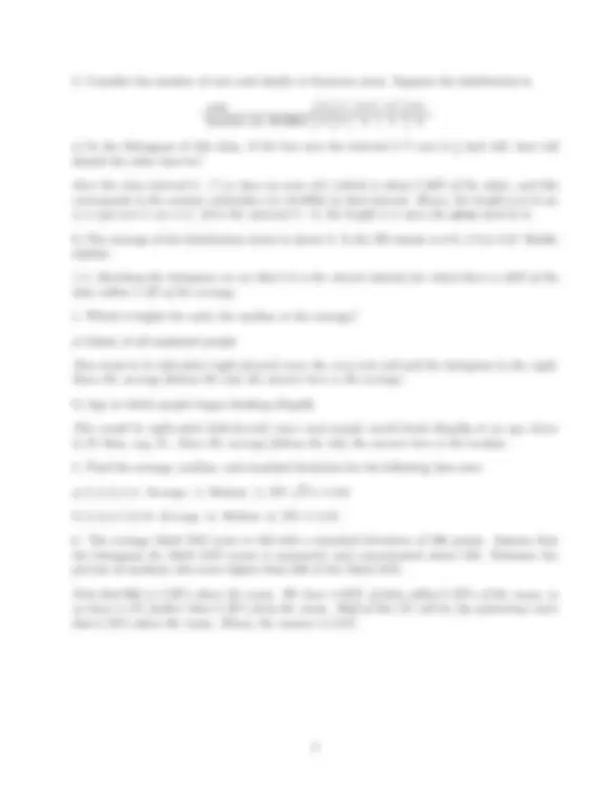



Study with the several resources on Docsity

Earn points by helping other students or get them with a premium plan


Prepare for your exams
Study with the several resources on Docsity

Earn points to download
Earn points by helping other students or get them with a premium plan
Community
Ask the community for help and clear up your study doubts
Discover the best universities in your country according to Docsity users
Free resources
Download our free guides on studying techniques, anxiety management strategies, and thesis advice from Docsity tutors
Material Type: Assignment; Class: Introduction to Statistics; Subject: Mathematics; University: Colgate University; Term: Unknown 1989;
Typology: Assignments
1 / 2

This page cannot be seen from the preview
Don't miss anything!


Math 102 & Core 143
Note: All data below is ficticious.
a) Age at death from natural causes. Right-sided (or left-skewed), as people who die from natural causes tend to be older
b) Age at death from murder. Left-sided (or right-skewed), as people who die from murder tend to be younger
c) Age at death from any cause. Symettric, as people of all ages die
Number of cars Number of households 0 120 10% 1 350 29 .2% 2 500 42 .7% 3 210 17 .5% 4 20 1 .7%
There are a total of 1200 household above, where the third column in the above table gives the corresponding percentages. Using the fact that the area of the rectangles in histograms represent respective percentages, we have the following histogram. (The heights are on top of the rectangles for clarity.)
cars 0 1 2-3 4-7 8+ families (in 10,000s) 4 5 8 1 0
a) In the histogram of this data, if the bar over the interval 4–7 cars is 14 inch tall, how tall should the other bars be?
Over the class interval 4 − 7 we have an area of 1 (which is about 5.56% of the data), and this corresponds to the number of families (in 10,000s) in that interval. Hence, the height over 0 car is 4 and over 1 car is 5. Over the interval 2 − 3 , the height is 4 since the area must be 8.
b) The average of the distribution above is about 2. Is the SD closest to 0.3, 1.3 or 2.3? Briefly explain.
1.3. Sketching the histogram we see that 1. 3 is the closest statistic for which there is 68% of the data within 1 SD of the average.
a) Salary of all employed people
This tends to be left-sided (right-skewed) since the very rich will pull the histogram to the right. Since the average follows the tail, the answer here is the average.
b) Age at which people began drinking illegally
This would be right-sided (left-skewed) since most people would drink illegally at an age closer to 21 than, say, 11. Since the average follows the tail, the answer here is the median.
a) 1, 2 , 3 , 4 , 5: Average: 3, Median: 3, SD:
b) 1, 3 , 5 , 7 , 9 , 11 Average: 6, Median: 6, SD: ≈ 3. 41.
Note that 650 is 2 SD’s above the mean. We have ≈ 95% of data within 2 SD’s of the mean, so we have ≈ 5% farther than 2 SD’s from the mean. Half of this 5% will be (by symmetry) more that 2 SD’s above the mean. Hence, the answer is 2 .5%.